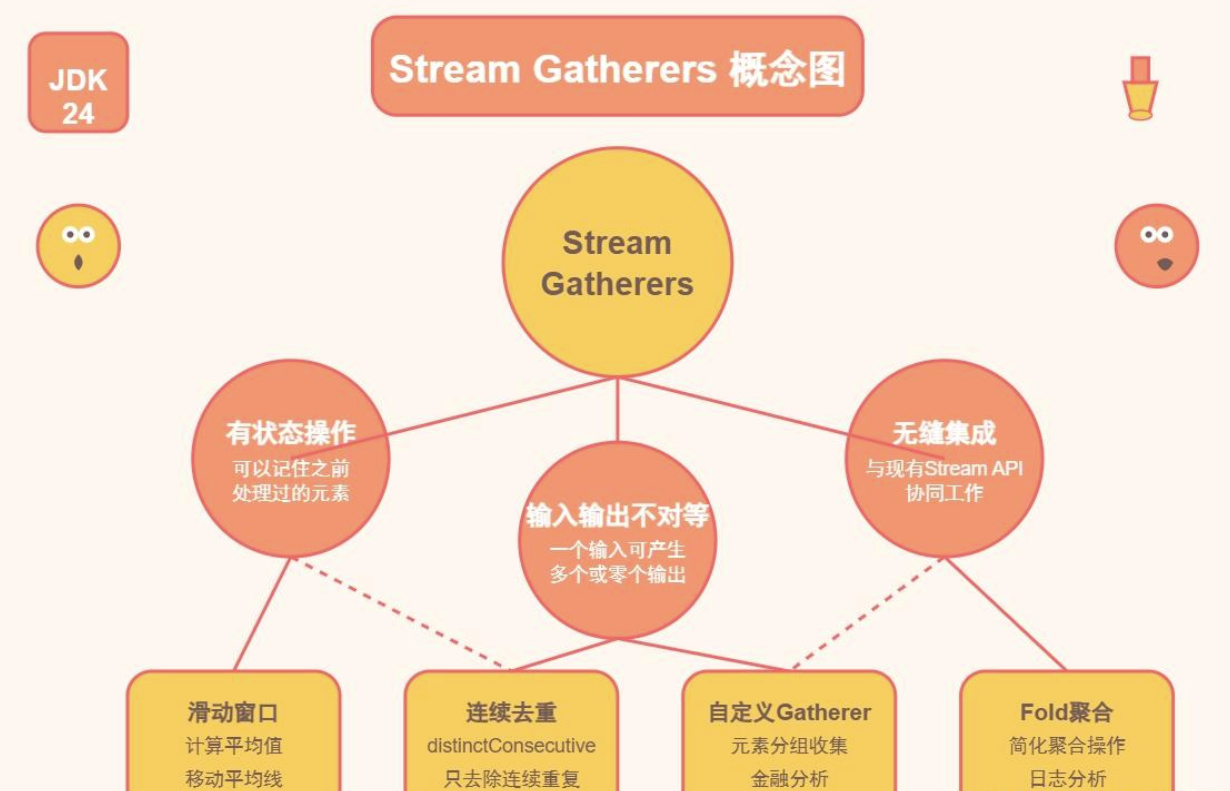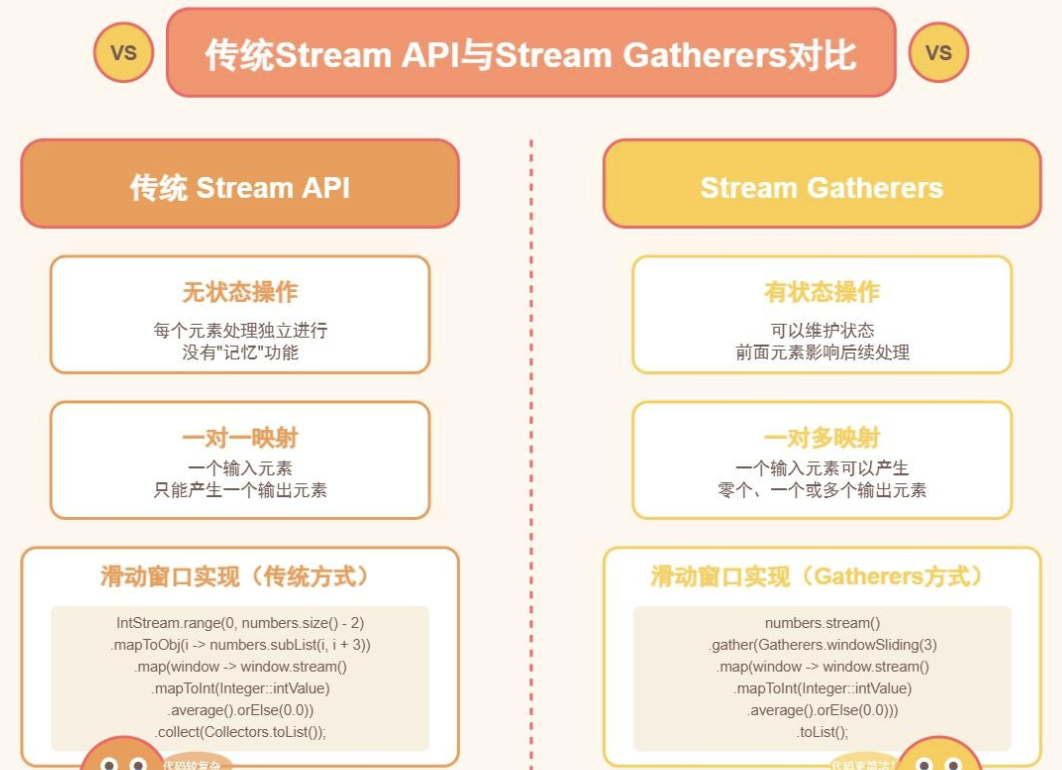
探索JDK24新特性!Stream Gatherers:一次革命性的流处理升级,代码量减半
还在为复杂数据流处理写一堆繁琐代码而头疼吗?还在为实现滑动窗口、状态管理等功能而绞尽脑汁吗? JDK 24带来了一项革命性特性——Stream Gatherers,它将彻底改变你处理数据流的方式。
想象一下,如果传统的Stream API是工厂生产线上的基础工序,那么Gatherers就是那个能记忆、能思考、还能一变多的"超级工序"。
本文将带你深入了解这个强大特性,让你的代码不仅更简洁,更具表达力,还能解决以前需要绕很大弯子才能实现的复杂场景。 无论你是处理金融数据、日志分析还是复杂业务逻辑,Stream Gatherers都能让你事半功倍!
一、Stream Gatherers是什么
Stream Gatherers是JDK 24中引入的一个强大新特性,它扩展了Java Stream API的能力,让我们能够更灵活地处理数据流。想象一下,如果传统的Stream API是一条生产线上的基础工序(如筛选、映射),那么Gatherers就像是更复杂的工序,可以记住之前处理过的元素,还能根据一个输入元素产生多个或零个输出元素。
传统Stream API(如map、filter、reduce)在处理某些复杂场景时有局限性,而Gatherers正是为解决这些限制而生的。

二、Stream Gatherers的核心特性
1、有状态操作
传统Stream操作如map是无状态的,每个元素处理都独立进行。而Gatherers可以在处理过程中维护状态,让前面元素的处理结果影响后续元素的处理方式。
2、输入输出数量不对等
在传统map操作中,一个输入元素只能产生一个输出元素。而使用Gatherers,一个输入元素可以产生零个、一个或多个输出元素。
3、与现有API无缝集成
Gatherers可以与原有Stream API一起使用,形成更强大的数据处理流水线。
三、通过代码示例详解Stream Gatherers
1、滑动窗口平均值计算
一个常见需求是计算数据的滑动窗口平均值,传统方式比较复杂,而使用Gatherers可以简洁实现。
这里的windowSliding(3)创建了一个滑动窗口,每次包含3个连续元素。当我们遍历[1,2,3,4,5,6,7,8,9]这个序列时,会生成窗口[1,2,3]、[2,3,4]、[3,4,5]等,然后对每个窗口计算平均值。
import java.util.List;
import java.util.stream.Gatherers;
public class SlidingWindowExample {
public static void main(String[] args) {
// 原始数据
List<Integer> numbers = List.of(1, 2, 3, 4, 5, 6, 7, 8, 9);
// 计算大小为3的滑动窗口的平均值
List<Double> averages = numbers.stream()
.gather(Gatherers.windowSliding(3) // 创建大小为3的滑动窗口
.map(window -> window.stream() // 对每个窗口计算平均值
.mapToInt(Integer::intValue)
.average()
.orElse(0.0)))
.toList();
System.out.println("滑动窗口平均值: " + averages);
// 输出: [2.0, 3.0, 4.0, 5.0, 6.0, 7.0, 8.0]
}
}2、去除连续重复元素
需要去除列表中连续重复的元素?Gatherers提供了现成的解决方案,注意这里与传统的distinct()方法不同,distinctConsecutive()只去除连续重复的元素,如果同样的元素在列表中不相邻出现,则会保留。
import java.util.List;
import java.util.stream.Gatherers;
public class DistinctConsecutiveExample {
public static void main(String[] args) {
List<String> words = List.of("apple", "apple", "banana", "banana", "apple");
// 去除连续重复元素
List<String> distinct = words.stream()
.gather(Gatherers.distinctConsecutive())
.toList();
System.out.println("原始列表: " + words);
System.out.println("去除连续重复后: " + distinct);
// 输出: [apple, banana, apple]
}
}3、自定义Gatherer - 分组收集
Gatherers真正的威力在于可以创建自定义的转换操作。以下是一个将元素按指定大小分组的示例:
这个例子创建了一个自定义的Gatherer,它将流中的元素每3个一组收集成子列表。最后一组可能不足3个元素。
import java.util.ArrayList;
import java.util.List;
import java.util.function.Supplier;
import java.util.stream.Gatherer;
public class CustomGathererExample {
public static void main(String[] args) {
List<Integer> numbers = List.of(1, 2, 3, 4, 5, 6, 7, 8, 9, 10);
// 自定义Gatherer: 将元素按照指定大小分组
Gatherer<Integer, List<Integer>, List<Integer>> chunking = Gatherer.of(
// 初始状态提供者(创建一个空的ArrayList作为初始"积累器")
(Supplier<List<Integer>>) ArrayList::new,
// 处理元素的核心函数(accumulator, element, downstream)
(chunk, element, downstream) -> {
chunk.add(element); // 将当前元素添加到积累器中
// 当chunk达到大小3时,发送到downstream并创建新的chunk
if (chunk.size() == 3) {
downstream.push(List.copyOf(chunk)); // 发送不可变的副本
chunk.clear(); // 清空积累器,准备收集下一组
}
return true; // 继续处理后续元素
},
// 完成处理时的函数(处理可能剩余的元素)
(chunk, downstream) -> {
if (!chunk.isEmpty()) {
downstream.push(List.copyOf(chunk));
}
}
);
// 使用自定义Gatherer
List<List<Integer>> chunks = numbers.stream()
.gather(chunking)
.toList();
System.out.println("分组结果: " + chunks);
// 输出: [[1, 2, 3], [4, 5, 6], [7, 8, 9], [10]]
}
}4、使用fold简化聚合操作
Gatherers还提供了fold方法,简化了一些聚合操作:
import java.util.HashMap;
import java.util.List;
import java.util.Map;
import java.util.stream.Gatherers;
public class FoldExample {
public static void main(String[] args) {
List<String> fruits = List.of("apple", "banana", "apple", "cherry", "banana", "apple");
// 使用fold统计每个水果出现的频率
Map<String, Integer> frequencies = fruits.stream()
.gather(Gatherers.fold(
HashMap::new, // 初始状态
(map, fruit) -> { // 累加函数
map.put(fruit, map.getOrDefault(fruit, 0) + 1);
return map;
}
));
System.out.println("水果出现频率: " + frequencies);
// 输出: {banana=2, apple=3, cherry=1}
}
}这个例子使用fold操作将流中的元素收集到一个Map中,统计每个元素出现的次数。

5、与传统Stream API的对比
为了更清晰地展示Stream Gatherers的优势,我们来比较一下实现滑动窗口的两种方式:
// 传统方式实现滑动窗口 - 代码较复杂
List<Double> traditionalWay = IntStream.range(0, numbers.size() - 2)
.mapToObj(i -> numbers.subList(i, i + 3))
.map(window -> window.stream()
.mapToInt(Integer::intValue)
.average()
.orElse(0.0))
.collect(Collectors.toList());
// 使用Gatherers实现 - 代码更简洁、更直观
List<Double> withGatherers = numbers.stream()
.gather(Gatherers.windowSliding(3)
.map(window -> window.stream()
.mapToInt(Integer::intValue)
.average()
.orElse(0.0)))
.toList();四、Stream Gatherers的实际应用场景
1、金融分析师经常需要计算各种技术指标如移动平均线、相对强弱指数(RSI)等。
这个例子展示了如何使用滑动窗口计算股票的5日和20日移动平均线,这在传统方法中需要编写大量样板代码。
import java.util.*;
import java.time.LocalDate;
import java.util.stream.Gatherers;
public class StockAnalysisExample {
record StockPrice(LocalDate date, double price) {}
record MAResult(LocalDate date, double price, double ma5, double ma20) {}
public static void main(String[] args) {
// 股票历史价格数据
List<StockPrice> prices = List.of(
new StockPrice(LocalDate.of(2024, 1, 1), 150.25),
new StockPrice(LocalDate.of(2024, 1, 2), 152.50),
// ... 更多数据
new StockPrice(LocalDate.of(2024, 1, 30), 168.75)
);
// 使用Gatherers计算5日和20日移动平均线
List<MAResult> movingAverages = prices.stream()
.gather(Gatherers.windowSliding(20)
.map(window -> {
StockPrice latest = window.get(window.size() - 1);
// 计算5日均线
double ma5 = window.size() >= 5 ?
window.subList(window.size() - 5, window.size()).stream()
.mapToDouble(StockPrice::price)
.average()
.orElse(0) : 0;
// 计算20日均线
double ma20 = window.size() == 20 ?
window.stream()
.mapToDouble(StockPrice::price)
.average()
.orElse(0) : 0;
return new MAResult(latest.date(), latest.price(), ma5, ma20);
}))
.toList();
// 输出结果
movingAverages.forEach(System.out::println);
}
}金融监控系统需要检测价格异常波动:
public static List<StockPrice> detectPriceAnomalies(List<StockPrice> prices, double threshold) {
return prices.stream()
.gather(Gatherers.scan(
new double[]{0, 0}, // 初始值:[前一天价格, 变化百分比]
(state, price) -> {
double previousPrice = state[0];
double percentChange = previousPrice > 0 ?
(price.price() - previousPrice) / previousPrice * 100 : 0;
// 更新状态
state[0] = price.price();
state[1] = percentChange;
return state;
})
.filter(result -> Math.abs(result[1]) > threshold)
.map(result -> prices.get((int)result[0])))
.toList();
}2、在Web服务器日志分析中,需要将用户点击流分组为会话:
本文系作者在时代Java发表,未经许可,不得转载。
如有侵权,请联系nowjava@qq.com删除。
